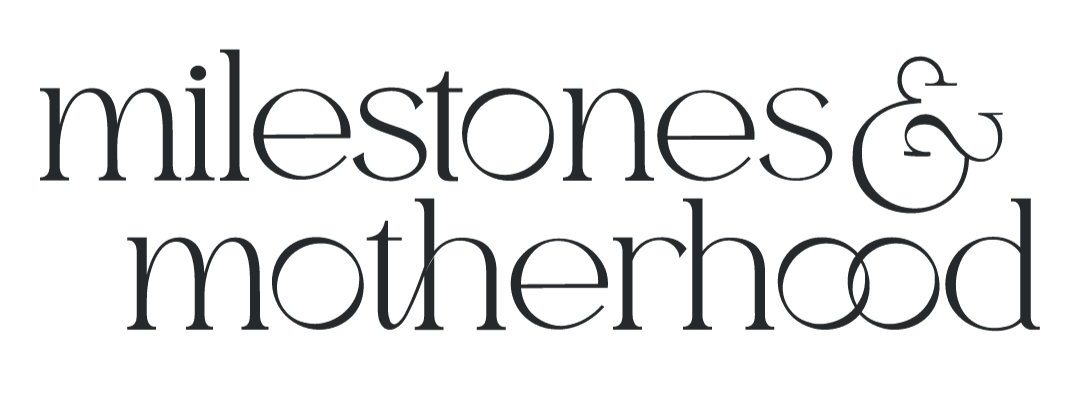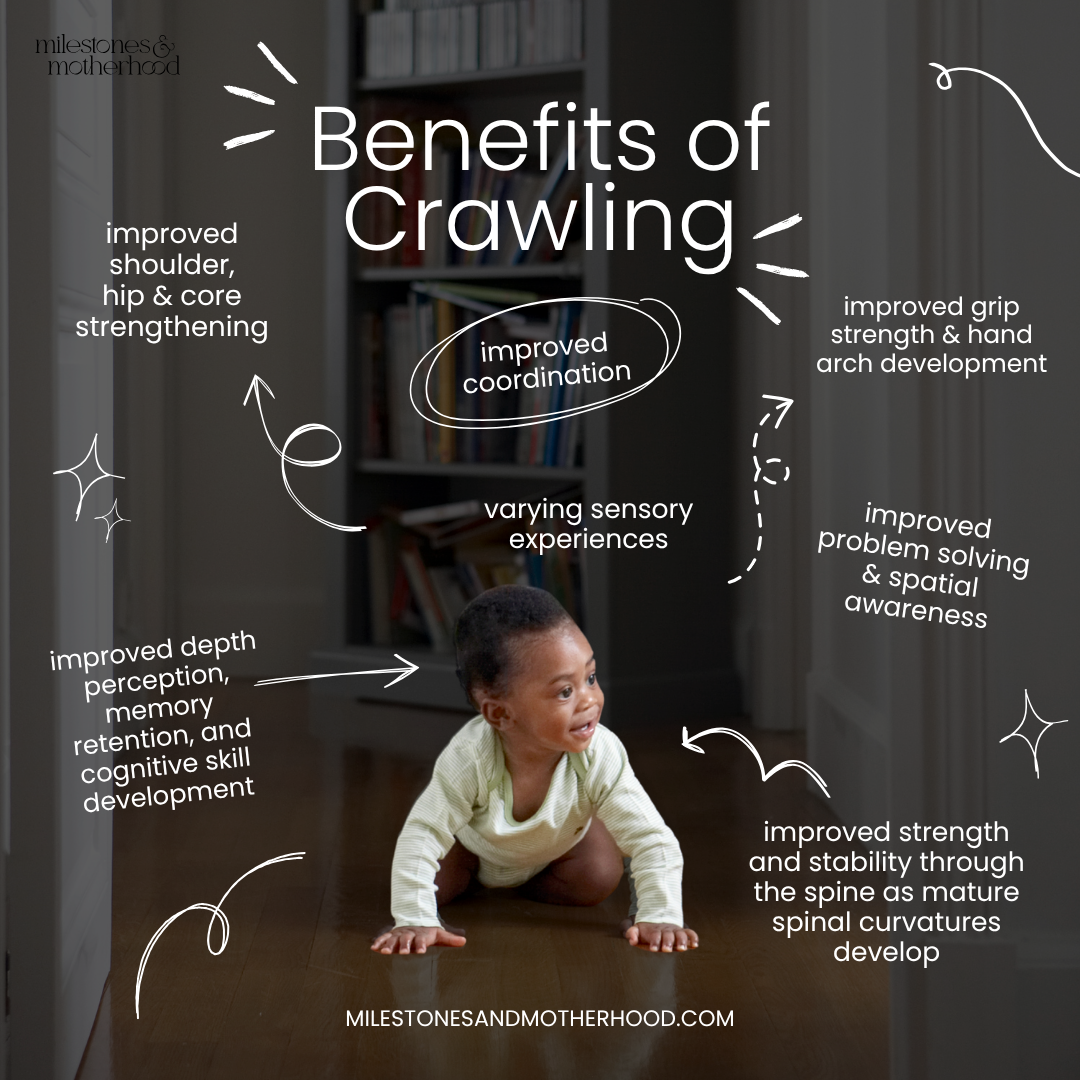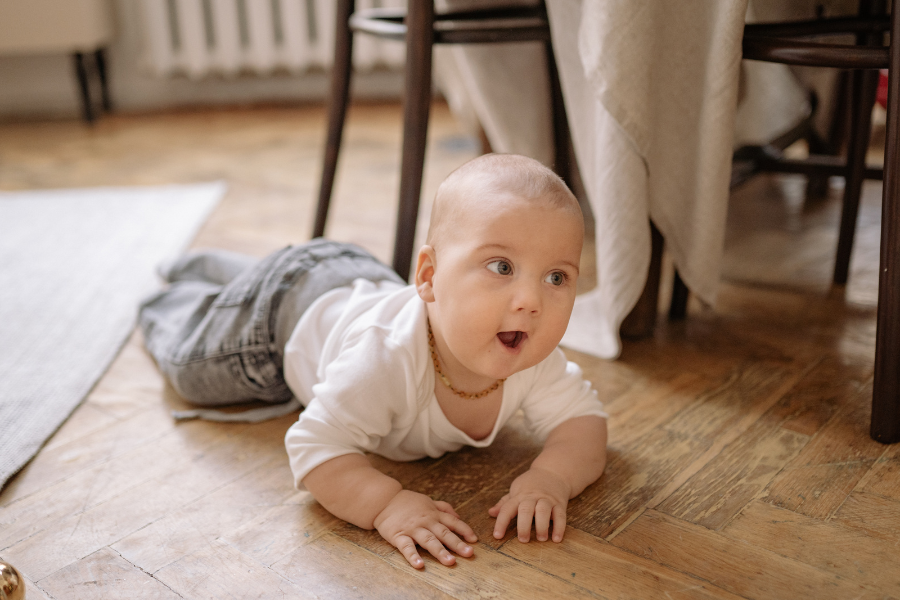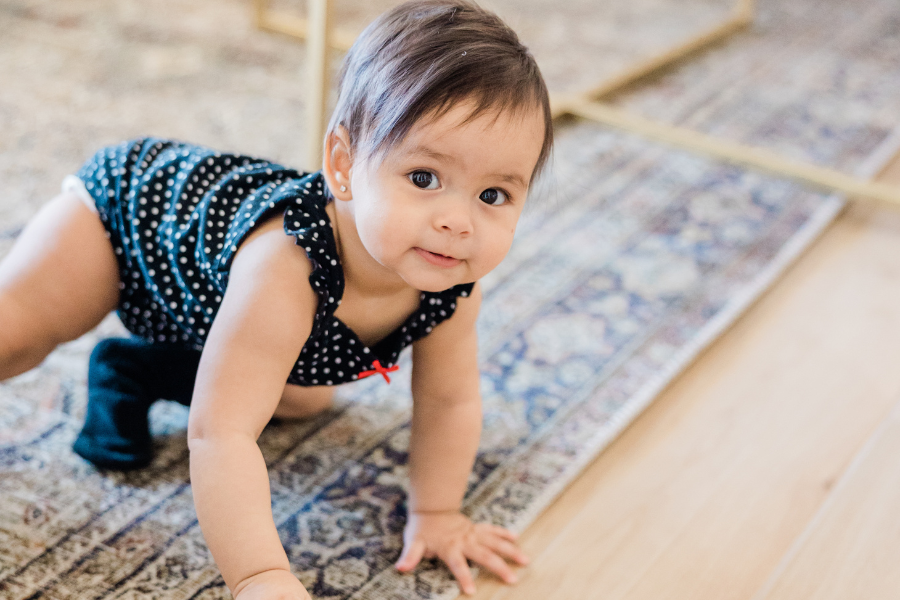Is My Baby Crawling Wrong? What to Know About Asymmetrical or Unusual Crawling
This post may contain affiliate links, which means I may earn a small commission at no extra cost to you, if you make a purchase through one of my links. I only share products I truly love and use for myself or with my own kids and patients. Thank you for supporting this space!
Is My Baby Crawling Wrong?
If you’ve ever seen your baby channel their inner animal while crawling - like a bear on hands and feet, slithering on their belly like a snake, or with one leg hiked up like a little crab - you may be wondering….what the heck is that? Is that normal?!
And as a pediatric physical therapist & mom of 3 myself, TRUST ME, I get it!
While there are lots of (totally normal!) ways babies start to move on their way to hands and knees crawling, the ‘weird’ ways they’re moving often DO give us a lot of information about where our baby currently is, where they’re headed, and where they may benefit from some support. So, let’s unpack it all - the weird ways babies crawl, what’s normal & what’s not, and what parents really need to know to keep their babies on track & thriving.
And if you’re looking for play based crawling support & tips you can start implementing from the comfort of your home TODAY, check out my totally FREE workshop, Crawling with Confidence.
The Crawling Milestone Explained
Why it Matters, What Different Crawling Styles Mean, What ‘Counts’ as Crawling, & What You Need to Know to Support Your Child’s Crawling Journey
First, The Great Crawling Controversy…who’s right, who’s wrong, and does crawling really matter?
I realize by nature of my profession, I’m obviously a touch biased, but I’m here to tell you wholeheartedly, YES, crawling matters SO, so much. I’d actually argue it may be the most important milestone of all because of its immense benefits in SO many areas of our little’s development.
From the obvious physical, strength & coordination benefits, to the maybe less obvious cognitive, brain related, social emotional and even communication benefits—crawling is truly a powerhouse of development and helps lay the foundation for some seriously exciting milestones to come.
Crawling on hands and knees is so much more than just a mode of movement, it's a comprehensive exercise that engages multiple muscle groups, fosters coordination, strengthens core muscles, strengthens communication between both sides of the brain, aids in vision development, encourages spatial awareness AND SO MUCH MORE.
It even helps to set the stage for future fine motor skills like handwriting, lays the foundation for reading skills, aids in hand-eye coordination development, postural control & balance, and even encourages communication skills as well! SO cool, right?!
Simply put, hands and knees crawling is such an exciting stepping stone towards supporting your child's future achievements and is absolutely a milestone worth fighting for!
The Facts About Crawling
Quickly, let’s talk about the benefits of crawling and why it is so important, but often overlooked! “I never crawled and I’m fine!”... “does crawling really even matter though?”...”my little one wants to skip right to walking!” Things I’m sure, as parents, we’ve all heard.
But honestly, crawling on hands and knees is such an important milestone, arguably the most important one from a motor development standpoint, and should absolutely be encouraged, in my opinion!
Here are some of the reasons why.
Current research suggests that crawling on hands and knees has the following benefits for children, as compared to children that did not crawl:
Improved coordination
Crawling is one of the first milestones that requires cross-lateral movement (moving the opposite arm and leg simultaneously). This causes MAJOR communication between both sides of the brain, which means coordination & strength!
Improved grip strength & hand arch development
During crawling, a child weight bears on open hands, which provides immense sensory input to the palms of the hand, lengthens AND strengthens muscles, and contributes to improved fine motor skill development, like handwriting!
Improved problem solving & spatial awareness
As a child crawls through their environment, they have to become aware of not only their body position in relation to things surrounding them, but also how to get around obstacles within their path.
Improved shoulder, hip & core strengthening
As a child gets up into hands and knees, they are working in a more dynamic way against gravity, which strengthens those important muscle groups and supports the developing spinal curves.
Improved strength and stability through the spine as mature spinal curvatures develop
Newborns have a C-shaped spine from the in-utero positioning, known as the PRIMARY curve. The neck and lower back are SECONDARY curves, because they develop as a child lifts their head in tummy time, sits, crawls, and stands. These are S-shaped curves. The cervical curve develops in months 3-4 of life as baby lifts their head in tummy time. The lumbar curve develops as baby starts to press up when on their belly, pivot around, and crawl on all fours. These begin around month 5, and continues until baby is walking. The more time a baby has to develop that curve on the floor through crawling and strengthenIng the muscles, the more supported the spine will be in upright positions!
Improved depth perception, memory retention, and cognitive skill development.
Varying sensory experiences—as a child crawls up and over differing textures & surfaces
Why Hands & Knees Crawling Really Matters...Or Does It?
Is hands and knees crawling the only thing worth working for? While it is certainly the ‘gold standard’ and the crawl we are aiming for, any movement is a good thing and gives us so much we can work with to get your child to hands and knees. Some of the most common questions I get are along the lines of, ‘what actually ‘defines’ crawling?’, or ‘is it ok if my little one only ever Bear crawls, army crawls, or butt scoots, or 3 legged hitch crawls?’ and I get it! It can be confusing, especially with conflicting information, so let’s clear it up!
Unraveling Common Crawling Variations
Again, in general, crawling on hands and knees is considered the ‘gold standard’ we are aiming for, as it truly shows that a child has developed the immense strength, coordination and mobility in BIG important muscle groups to achieve it.
And while variations like:
Army Crawling (aka belly crawling, inchworming, commando crawling where the belly remains on the floor & arms & legs move alternately)
Bear Crawling (Crawling on hands & feet with bottom in the air)
Butt Scooting (Aka bum shuffling or bottom shuffling where they are moving in a sitting position by scooting on their bottom)
Hitch/3 legged/asymmetrical Crawling (Crawling with one leg up & the weight on their foot rather than knee and/or a combination of butt scooting & 3 legged crawling)
….might seem common (and/or may be present right alongside hands and knees at times), if they are the ONLY way your child can crawl or are the preferred method more than 50-60% of the time, we definitely want to be sure there isn’t anything underlying contributing to that variation that can actually impact overall development.
Sometimes, variations may be present for reasons as simple as a child starting to army crawl because they are MOTIVATED and just want to GO, but don’t quite have the strength & coordination yet to get on hands and knees, and that’s okay! Sometimes, the crawling variation may happen for a brief period (like with bear crawling) as they learn a NEW skill, like rising into stand (more on that below!) - And sometimes, there may be a bit more contributing to crawling variations, like often is the case with butt scooting and 3 legged crawling.
Again, if those variations are the ONLY or primary (more than 50-60% of the time) way they can navigate their environment independently, doing some investigative work to uncover the WHY can be a game changer in addressing that why & getting them to that gold standard hands and knees crawl—and the best part? It’s relatively easy to do just that with the right support & guidance....aka, I’VE GOT YOU!
The Common Crawling Styles Parents Ask About Most & My Top 3 Tips for Supporting Hands & Knees Crawling:
Army Crawling (Aka belly crawling/the inchworm/commando crawling)
Army crawling refers to a child moving forward (or commonly backwards initially!) with their belly remaining in contact with the ground the entire time. It’s also referred to as belly crawling or commando crawling, with variations within army crawling based on how baby is moving their arms and legs. In general during belly crawling, the arms and legs will help pull/push the body forward in an alternating fashion, just like hands and knees crawling. Think: right arm pulls, left leg pushes, then left arm pulls, right leg pushes.
While Army crawling is NOT a ‘requirement’, it IS typically a pre-cursor to hands and knees crawling (the ‘gold standard’ we are looking for. See the massive benefits of it here!) and often occurs when a child is super motivated to move, but hasn’t quite nailed down the strength & coordination required to hands and knees crawl yet.
Many babies that DO army crawl will often start exploring it around the 5-6 month mark. This is when crawling ‘ministones’ as I like to call them, really ramp up. Those crawling ministones are the little skills that act to lay the foundation for the big milestone to occur, in this case crawling on hands and knees.
But what if army crawling is sticking for your baby? When do we want to see the transition to hands and knees?
While there is no set time limit, this is definitely a nuanced conversation. In my opinion, it’s less about specific timelines and more about seeing forward progress.
I explain this in MUCH more depth in my army crawling blog, along with tangible tips you can start implementing today to support your baby, you can check it out HERE!
Butt Scooting (AKA bum shuffling/bottom scooting)
This is a BIG one that I cover much more in depth in my free Crawling With Confidence workshop because it’s SO nuanced but SO important. If you have a little one scooting on their bottom, I highly recommend you hop in here to learn more!
When it comes to bottom scooting, which is when baby remains in a sitting position while scooting forward, just like other crawling variations, if it's something they do along with other movement patterns (like an army crawl or hands and knees occasionally), it wouldn't be a major concern.
However, if it's the ONLY way they can get around, it does generally indicate that something is restricting them, whether that be weakness through their core or hips, poor range of motion through their hips, poor shoulder strength (often from tummy time struggles) or more. And the bigger issue with bottom scooting is it’s impact on a baby’s ability to progress through transitions, often becoming more and more obviously concerning as baby begins to try to pull themselves into standing from the bottom scooting position and simply isn’t able to. This is when it really begins to impact progress towards walking milestones and children fall behind - becoming the time when when these butt scooting babes get referred for individualized services, despite parents often noting concerns months prior to this.
Again, when it comes to bottom scooting, if it is the ONLY pattern of movement you're seeing, especially in combination with a history of tummy time struggles, reflux, or difficulty with transitioning into and out of sitting on their own, I'd definitely want to investigate a little further and figure out the why behind it. If that’s your situation, please DON’T stress, but please DO hop into that free workshop to learn how you can start supporting your little one today!
Bear Crawling (on hands & feet)
Bear Crawling, which is when baby is on hands and feet with their bottom in the air), is another commonly seen variation parents ask about SO ofte, usually wondering ‘is there ever a time when it’s normal?’
The short answer…ABSOLUTELY! There are periods in development where seeing the bear crawl and/or your child going into the ‘downward dog’/bear crawl position is not only NOT a concern, but it’s actually developmentally significant and a sign that a new skill may be right on the horizon, woohoo! (If you’re looking to deep dive into all things ‘downward dog’ and development (beyond the Old Wives Tales 👀), check out THIS blog.)
The long(er) answer…..
Oftentimes, we see bear crawling and/or the static downward dog position at a few different key points in development: prepping for crawling, pre-walking/early walking, and toddlerhood. I break that all down in way more depth in my Bear Crawling blog, which you can check that out HERE!
3-Legged/Asymmetrical Crawling
Finally, let’s talk about the 3-legged crawl and other forms of asymmetrical crawling, which are basically when either one leg is out to the side in a kickstand position (3 legged), baby is using one arm or leg more than the other (asymmetrical), or what I refer to as a ‘hybrid’ crawl where baby has one leg hitched up similar to the 3 legged, but is also more seated on their bottom & pulling with one hand & the hitched leg. Ultimately, these are all signs of asymmetry in strength or range of motion and can quickly become habitual. And while there ARE absolutely times these can be a normal part of development, resolving naturally as baby moves & strengthens - many times, babies demonstrating these crawling variations do need a nudge in the right direction.
But WHY do we want to address asymmetrical crawling?
*A note on symmetry in development, meaning what one side of the body can do, the other side should be able to!* If crawling variations are asymmetrical, meaning only one arm or leg is doing most of the work, it’s worth mentioning to your pediatrician and being sure no follow up with a pediatric physical therapist is warranted. While periods of asymmetrical crawling can be an absolutely normal part of the learning process, symmetry in development in the first 1-2 years of life is so important for brain development and truly, it’s always worth ensuring no other asymmetries or concerns around strength or coordination are present, in my opinion!
My Top 3 Tips for Encouraging Healthy Crawling Patterns
Supporting the transition from many of these crawling variations to hands & knees crawling:
Consider Environment Set Up: When your little one is on the floor exploring, placing things around them that are varying heights (think: a small stool, a couch cushion or mattress on the ground, diaper boxes on their side) can be a REALLY simple way to support not only the transition to hands & knees crawling, but also the transition into standing from squatting!
Obstacle Play: This is HUGE for supporting the transition to hands and knees from the bear crawl position! Placing obstacles within their path (sticking your legs out as they crawl past you, having pillows or towels/blankets within their path, etc) often forces them to drop to their knees in order to successfully navigate it. Added bonus, it’s FUN and super silly, and kids often love navigating around them!
Supervised Stair Play: If you have stairs in your home, I can’t recommend beginning to teach your child how to safely navigate them as soon as they become mobile. I know it can be intimidating, but you can truly be the most attentive parent in the world and things happen, big kids leave a gate open, a dog pushes through a gate, and knowing your child knows how to be safe is HUGE for your peace of mind and their safety! More on teaching stair and furniture safety can be found HERE. And while stair safety is important for so many obvious reasons, supporting your little one in navigating the stairs in a crawling position ALSO really works on that transition to hands & knees crawling, as again, it forces those knees down & targets strengthening the exact muscle groups we need! Win, win if you ask me!
Why Do Babies Crawl in So Many Different Ways?
While there can be so many underlying reasons for seeing crawling variations in our babies - from taking the path of least resistance to strength, coordination, sensory feedback & more - what matters most is figuring out the why behind the variation for your unique child. Because crawling isn’t just about mobility, it’s a whole body (& brain!) skill. And being able to tease out what your child needs and where to turn next -whether it’s support from home (I got you!) OR advocating for more individualized support outside the home, is the best way to feel confident & empowered that you’re supporting your unique child & their journey towards crawling.
Learning how to assess your baby, align their play space & environment with intention and FUN, and activate to best support what they need is exactly what I break down for you in my totally free crawling workshop. Because after over a decade in this field and the honor of having worked with thousands and thousands of families, I can confidently say that the best way to support our babies is by first supporting parents - and that’s exactly what I’m here to do. ❤️
But What If It Is Seeming Like Baby is Stuck In a Variation & May Skip Crawling? How Do I Know When To Watch Vs. When to Seek Help?
Again, if one of the variations covered is the primary or only way your child is able to successfully explore their environment, it’s always worth discussing a referral with your pediatrician so you can investigate a bit further with a pediatric therapist. This referral can be to your state/county’s Early Intervention program (find your contact number HERE), or to a private pediatric therapist if your insurance allows it.
And if you’re in the waiting process for a referral or are just looking for more information on:
When to watch vs when to seek help & common ‘red flags’ that indicate baby needs more support
Understanding your baby’s development so you can best support the stage they’re in now AND foster where they’re headed
Knowing exactly how to encourage healthy crawling patterns & your child’s development through play, ALL from the comfort of your home
& so much more….
I’ve got exactly what you need right here!
And please hear me when I say this - does ANY of this mean your child is doomed, even if they do or have already skipped crawling? Absolutely NOT.
Remember you can ALWAYS take your child back down and practice crawling! Play tunnels, build forts to crawl through, play animal games (pretend to be a dog or bear, whatever!), crawl up a slide or stairs, even if they don’t use it as their primary means of mobility, you can still get similar benefits!
Lastly, if you’ve been around awhile, you know that I firmly believe you do not need all the things (or really any of the things!) for your child to master their motor milestones. But if you’re looking for ideas, you can find my thoroughly tested, tried & true favorite toys that are super fun AND encourage crawling (and the ministones that lead to it!), right here.
I hope this helps, and remember, while we do love to see hands and knees, ANY movement matters and is a wonderful sign that your little is on their way to exploring their world, learning & GROWING!
Happy Crawling, friends!
Was this helpful? Save it for later or share it with a friend!














